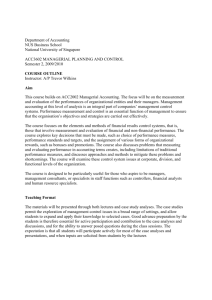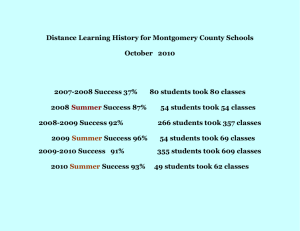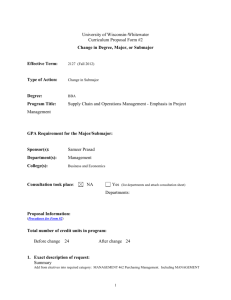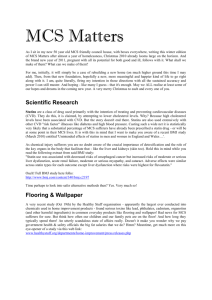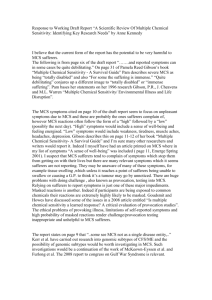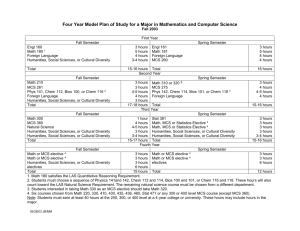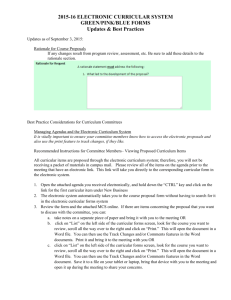Powerpoint
advertisement
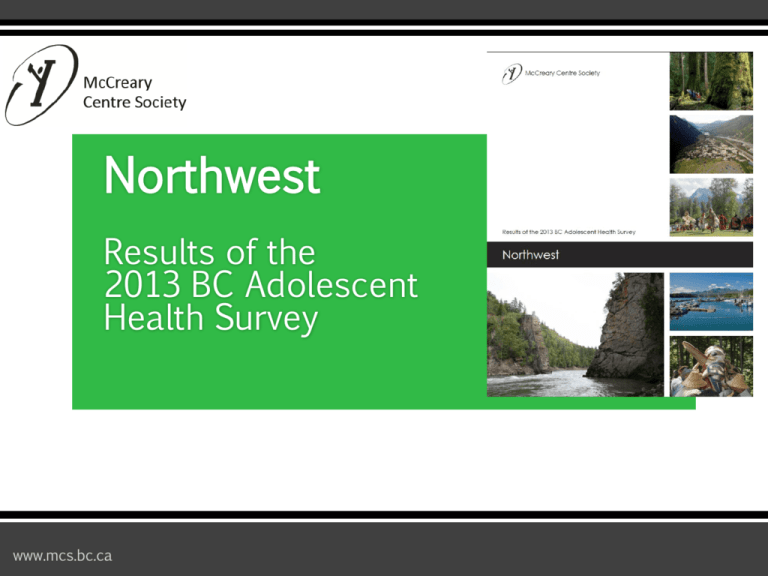
Northwest Results of the 2013 BC Adolescent Health Survey www.mcs.bc.ca 2013 BC Adolescent Health Survey ▪ Background ▪ Physical health ▪ Mental health ▪ Substance use ▪ Bullying, violence and abuse ▪ School, work and leisure ▪ Protective factors www.mcs.bc.ca Administration 2013 BC Adolescent Health Survey ▪ 29,832 surveys completed ▪ 1,645 classrooms ▪ 56 school districts ▪ 325 PHN’s and nursing students www.mcs.bc.ca Background www.mcs.bc.ca Youth in Northwest ▪ 54% reported European heritage ▪ 45% reported Aboriginal heritage ▪ 4% of students were born outside of Canada ▪ 60% of students spoke only English at home www.mcs.bc.ca Home life ▪ 92% of students lived with at least one parent ▪ Local males more likely to have run away ▪ 25% moved from one home to another ▪ 3% currently living in government care www.mcs.bc.ca Transportation to school How youth usually got to school Northwest BC 58% 50% 40% 42% 37% 28% Walk, bike, skateboard Car Bus or public transit Note: The difference between local students and those throughout BC who usually got to school by walking, biking, or skateboarding was not statistically significant. www.mcs.bc.ca Physical Health www.mcs.bc.ca Overall health ratings 55% 29% 15% 2% Poor Fair Good Excellent Note: Percentages do not equal 100% due to rounding. www.mcs.bc.ca Most youth had seen a dentist in the past year Health conditions and disabilities ▪ 32% of students had at least one health condition or disability ▪ Females were more than twice as likely to report a mental health condition ▪ For many the condition was debilitating www.mcs.bc.ca Sleep Good/excellent mental health Good/excellent mental health in relation to hours slept last night 100% 77% 59% 84% 89% 66% 50% 0% 5 hours or less 6 Note: Not all differences were statistically significant. www.mcs.bc.ca 7 8 9 hours or more Nutrition ▪ Most youth (89%) ate fruit or vegetables at least once on the day before the survey ▪ Youth who ate fruit or vegetables three or more times reported better mental health ▪ 89% of youth never went to bed hungry www.mcs.bc.ca Injuries and injury prevention ▪ Males were more likely to be injured seriously enough to require medical attention ▪ The majority of students wore a seat belt when riding in a motor vehicle (66%) ▪ 24% always wore a helmet when riding a bike www.mcs.bc.ca Concussions ▪ 19% of youth had a concussion in past year ▪ Headaches were the most common symptom experienced ▪ Almost one in five youth who suffered a concussion did not seek medical help www.mcs.bc.ca Body weight and body image BMI weight categories Northwest BC Underweight 2% 3% Healthy weight 67% 76% Overweight 18% 15% Obese 13% 6% Note: The difference between Northwest and BC in being underweight was not statistically significant. www.mcs.bc.ca Sexual behaviour 31% of students ever had oral sex 32% ever had sexual intercourse Most common age for first having sex was 14 or 15 www.mcs.bc.ca Sexual behaviour Among all youth: 3% had ever been pregnant or caused a pregnancy 2% ever had an STI Among those who had ever had sex: 69% used a condom the last time they had sex 27% used drugs or alcohol last time they had sex www.mcs.bc.ca Mental Health www.mcs.bc.ca Ratings of mental health Mental health and overall health ratings 78% 83% Mental health Overall health 22% 17% Poor or fair www.mcs.bc.ca Good or excellent Mental health Most commonly reported conditions Depression Males Females 9% 20% Students who experienced extreme stress and despair in the past month Males Females 15% 12% Anxiety Disorder/Panic Attacks 5% ADHD 10% 16% 5% 4% Extreme stress Note: Youth could choose more than one response. www.mcs.bc.ca 5% Extreme despair Self-harm and suicide Youth who attempted suicide in the past year in relation to Males Females suicide attempts by friends or close friends Attempted suicide ▪ 10% self-harmed ▪ 10% considered suicide 36%* ▪ 29% self-harmed ▪ 21% considered suicide 15% 3% ▪ Neither 7% attempted family nor friend attempted suicide suicide 13% attempted Family or ▪friend Both family and friend attempted suicide suicide attempted suicide • The percentage should be interpreted with caution as the standard error was relatively high but still within a releasable range. www.mcs.bc.ca Substance Use www.mcs.bc.ca Tobacco 32% had ever tried smoking. Among those: ▪ 32% first started smoking at 12 old or younger ▪ 37% started smoking at 15 or older ▪ 48% smoked in the past month www.mcs.bc.ca Alcohol 57% had ever tried alcohol Among those: ▪ 67% first drank before turning 15 years old ▪ 45% had five or more drinks in a short period of time at least once in the past month www.mcs.bc.ca Marijuana 42% had ever tried marijuana Among those: ▪ 68% first used it before turning 15 years old ▪ 60% had used it in the past month www.mcs.bc.ca Substance use Substances other than alcohol and marijuana Prescription pills without a doctor’s consent 13% Mushrooms 9% Ecstasy/MDMA 6% Hallucinogens 6% Cocaine 5% Inhalants 3% Amphetamines 2% Crystal meth 2% Heroin 2% Steroids without a doctor’s prescription 2% Ketamine and GHB 1% www.mcs.bc.ca Substance use Most common reasons for using substances the last time (among those who ever used alcohol or other drugs) www.mcs.bc.ca I wanted to have fun 64% I wanted to try it/experiment 28% My friends were doing it 28% Because of stress 25% I felt down or sad 19% I felt like there was nothing else to do 15% To manage physical pain 8% I was pressured into doing it 6% I thought it would help me focus 5% Because of an addiction 4% I didn’t mean to do it 2% Other 17% Bullying, violence and abuse www.mcs.bc.ca Bullying In the past year: ▪ 36% of students were teased to the point where they felt bad or extremely uncomfortable ▪ 35% were socially excluded ▪ 9% were physically attacked or assaulted www.mcs.bc.ca Percenteage of yout who bullied others Perpetrators of bullying Youth who were bullied in relation to number of different types of bullying they experienced in the past year (teased, excluded, assaulted) 39% 26% 11% Victim of 0 types of bullying www.mcs.bc.ca Victim of 1 type of bullying Victim of 2 types of bullying Cyberbullying ▪ 17% of students were cyberbullied in past year ▪ 8% cyberbullied someone in past year ▪ Females were almost 3 x as likely as males to report meeting someone online who made them feel unsafe www.mcs.bc.ca Discrimination Perceived reasons for being discriminated against in the past year www.mcs.bc.ca Physical appearance 21% Being seen as different 17% Race, ethnicity, or skin colour 15% Age 11% Sexual orientation (being or thought to be gay or lesbian) 7% Gender/sex 6% Income or family income 6% A disability 4% Physical and sexual abuse ▪ 16% of students were physically abused ▪ 14% of students were sexually abused ▪ Females were 3 x more likely than males to have been sexually abused (21% vs. 7%) www.mcs.bc.ca School, work and leisure www.mcs.bc.ca School safety Locations where students always or usually felt safe at school 93% Library www.mcs.bc.ca 91% Classroom 88% 88% 87% Cafeteria Getting to/from school Hallways 87% 84% Outside on Washrooms school property 83% Changing room Work Students who worked at a paid job during the school year 75% 61%* 50% 65%* 43% 30% 25% 24% 16% 0% 13 years old or younger 14 15 16 17 18 years or older * The percentage should be interpreted with caution as the standard error was relatively high but still within a releasable range. www.mcs.bc.ca Physical activity ▪ Males more likely than females to meet physical activity guidelines ▪ Younger students generally more likely to meet guidelines. ▪ Local students less likely to take part weekly in organized sports or exercise classes www.mcs.bc.ca Physical Activity Barriers to participation in activities Males Females Too busy 37% 52% Activity wasn’t available in community 20% 23% Couldn’t get there or home 10% 16% Couldn’t afford to 8% 12% Worried about being bullied 5% 12% Note: The difference between males and females who did not participate because the activity wasn’t available in their community was not statistically significant. Note: Youth could choose more than one response. www.mcs.bc.ca Technology ▪ Not having phone linked to: – Lower rates of self-harm in past year – Sleeping 8 or more on previous night ▪ Cellphone use linked to: – Supportive adult outside family www.mcs.bc.ca Protective Factors www.mcs.bc.ca Established Protective Factors School connectedness Positive family relationships Caring adults outside the family Someone to turn to for help www.mcs.bc.ca Established Protective Factors Peer relationships Good nutrition Feeling engaged and valued Stable home www.mcs.bc.ca Protective Factors 2013 8 or more hours of sleep Neighbourhood safety Community connectedness Cultural connectedness www.mcs.bc.ca Most students reported their overall and mental health as good or excellent The majority of students felt good about themselves, had things they were good at, and had an adult in their community that cared about them Promoting protective factors have and can continue to play a key role in improving outcomes for students www.mcs.bc.ca Using the Data 56 school district data tables 16 HSDA reports Sexual health report www.mcs.bc.ca Growing Up in BC Youth resources www.mcs.bc.ca Next Steps ▪ Youth-led projects and initiatives ▪ nextsteps@mcs.bc.ca In Our Shoes ▪ Bullying awareness video ▪ https://www.youtube.com/user/McCrearyCentre www.mcs.bc.ca Grants up to $500 for youth-led projects www.mcs.bc.ca Discussing the results ▪ Commentary on the AHS findings from: – Mary Ellen Turpel-Lafond, Representative for Children and Youth – Bob Lenarduzzi, President, Vancouver Whitecaps – And more! ▪ Video on McCreary’s YouTube channel www.mcs.bc.ca Northwest Results of the 2013 BC Adolescent Health Survey annie@mcs.bc.ca duncan@mcs.bc.ca www.mcs.bc.ca

